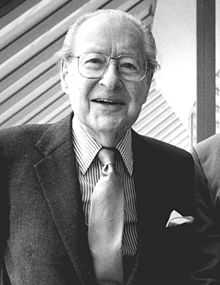Robert Sainsbury

Sir Robert James Sainsbury (24 October 1906 – 2 April 2000), was the son of John Benjamin Sainsbury (the eldest son of Sainsbury's supermarkets founder John James Sainsbury), and along with his wife Lisa began the collection of modern and tribal art housed at the Sainsbury Centre for Visual Arts in Norwich.
Early and family life
Robert Sainsbury was educated at Haileybury College and Pembroke College, Cambridge, before qualifying as an accountant.[1]
Sainsbury married Lisa Ingeborg (née Van den Bergh; 3 March 1912 – 6 February 2014) daughter of Professor Simon van den Bergh and Sonia Pokrojski.[2] They had four children Elizabeth (married name Clark; 19 July 1938 – 14 August 1977), Celia (b.1945, married name Blakey) and Annabel (b.1948, married Peter Kanabus had two children: Adrian Kanabus b. 1975, Jason Kanabus b. 1976, d. Jun 2006) David (b. 24 October 1940), later David Sainsbury, Baron Sainsbury of Turville.
Business career
In 1930, he joined the family grocery business founded by his grandfather, and became joint president almost 40 years later.
Robert Sainsbury was an advocate of better conditions for the retail chain's employees. Pensions and sickness benefits for all staff came in 1935; overtime payments were introduced in 1941; and, from 1962, the five-day week was standard.
Eight years after he joined the family firm, his father, John Benjamin Sainsbury, retired due to ill-health, and Robert Sainsbury and his elder brother Alan Sainsbury became joint general managers. While Alan Sainsbury took charge of trading matters, Robert Sainsbury specialised in administration, finance and personnel. It was a happy partnership, lasting more than 30 years.
The Second World War broke out a year after Robert Sainsbury's promotion, and there were rationed supplies at the 250 Sainsbury's shops.
Robert Sainsbury was a strong supporter of the Beveridge Report, which cradled the welfare state into being. By the end of the war, Robert Sainsbury had cut the long hours which under-18s had necessarily put in - with men conscripted and women on war work.
The 1950s brought self-service supermarkets. Over the period of his joint general management, deputy chairpersonship and chairpersonship (he became deputy chairperson when his father died in 1956, and succeeded his brother as chairperson in 1967), the company's turnover increased from £45m to £166m, and the number of employees rose fourfold.
By the time he retired as chairperson in 1969, Robert Sainsbury had been a principal architect of the supergrocer's fortunes, which insured its continuing success through to the beginning of the 1990s.
Charitable works
Robert Sainsbury was as an art collector and benefactor who gave his collection to the University of East Anglia, and was awarded a knighthood in 1969 for services to the arts.
In 1973, Robert Sainsbury made a gift to the University of East Anglia of several hundred paintings, drawings and sculptures from around the world, which he had bought over the decades. Designed by the architect Norman Foster, and with an endowment of £3m from Sainsbury's son David, the Sainsbury Centre for Visual Arts, built to house the works, opened in spring 1978.
References
- ↑ SAINSBURY, Sir Robert (James)’, Who Was Who, A & C Black, an imprint of Bloomsbury Publishing plc, 1920–2007
- ↑ Telegraph: Lady Sainsbury - obituary
| ||||||||||||||||||||||||||||||
|